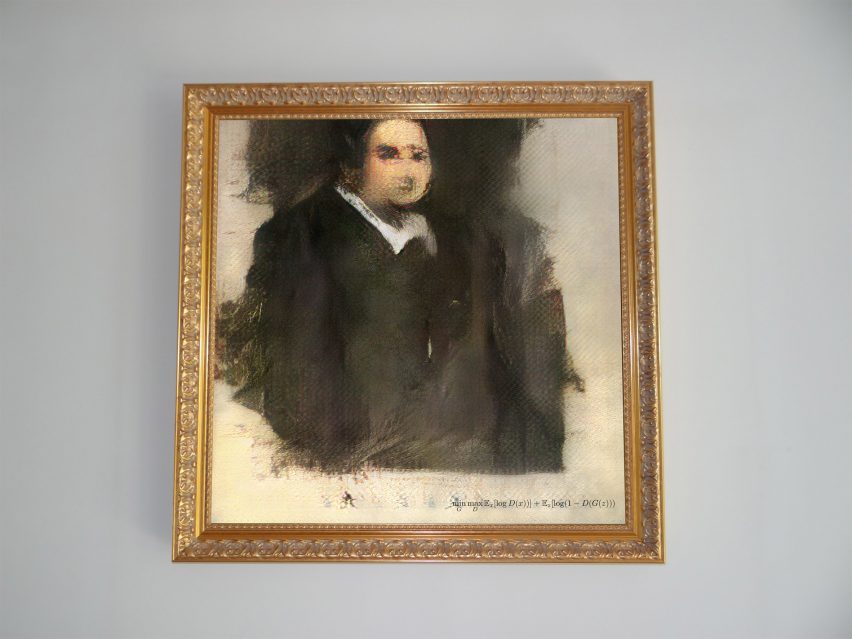Featured images of AI art courtesy of OBVIOUS Art.
Human interaction with artificial intelligence (AI) seems to be largely premised on optimising our convenience and nothing else: Driverless cars are designed to drive cars on your behalf, smart personal assistants are powered to answer your needs instantaneously, and even AI-powered advertisements are meant, however well, for you to have better use of the ads.
What tends to be overlooked is the tremendous progress AI has made beyond the realm of convenience.
Just last August 2018, for the first time in history, Christie’s in New York included AI-generated art in their auctions. For sale was the piece titled Portrait of Edmond Belamy (2018), created by an algorithm called the General Adversarial Network (GAN) used by the French art collective Obvious. Although its estimated selling price was listed at US$7,000 to US$10,000, it sold for US$432,500, more than 40 times its estimate.

While its monetary value may not compare to works by more established, classical artists (Claude Monet’s Le basin aux nymphéas (1917-1919) auctioned for $31,812,500 in the same year), it is safe to say that 2018 was the year that AI art began turning heads in the art world.
Outside of the successes of Edward Belamy, the revolution has also begun much closer to home. New Delhi’s Nature Morte, one of the largest contemporary art galleries in India, held the world’s first AI-focused art exhibitions last August. Titled “Gradient Descent”, works from seven international artists are put on exhibit, including Harshit Agrawal’s The Anatomy Lesson of Dr. Algorithm (2018).

Agrawal had intended the title to be a reference to the 16th century Rembrandt painting, The Anatomy Lesson of Dr. Nicholas Tulp. It was meant to parallel the “troubled fascination” the people experienced with medical technology in Rembrandt’s time to the same fascination we experience now, but with AI.
More than fascination however, what we experience today is a disruption by AI on the art world– AI’s permeation interrogates the fundamental relationship between the artist and their audience.
At the core of its interrogation is our pre-existing notions of art and creativity. If art is a creative expression of the self, it is safe to say that all artists are necessarily creative. In the world pre-AI, this line of argument is linear and undisputed; the artist has full creative authority and rights of the piece. We don’t question whether Van Gogh is the creative behind Sunflowers– we know he is.
AI however disrupts this linear process. In a world where art can be conceived through a collaboration between machine and humans, we find ourselves asking, who is the artist?
Dr. Algorithm for example was developed through a process of feeding a machine learning algorithm 60,000 images of human surgical dissections. The AI then reconstructs a new image based on these images. It may therefore be disputed whether the artist is Agrawal (who fed the machine those 60,000 images) or the machine (which generated from those 60,000 images the 20 unique prints).
One answer is that if art is a creative expression of the self, it follows that the intentions behind the piece should matter more than the actual doing– the machine is merely a medium for this intention to be expressed.
Perhaps then Agrawal is indeed the artist rather than the machine; he intended to create Dr. Algorithm using 20 unique prints of human surgical dissection, to comment on the parallel between our time and Rembrandt’s, and the machine happened to be his chosen medium.
No matter the conclusion, the question of whether it matters at all arises:
What is the value of knowing who created the piece, as long as we like what we see?
To answer this, we need to address a more fundamental question of what makes art tick for us. A few things come to mind: the unemotive, the aspect of aesthetics or the evocative and emotional self (i.e the intentions of the artist) behind it.
There is probably no answer that will satisfy all of us. In fact, there is as much a good chance that we are drawn to the self as we are drawn purely to its aesthetics.
However, we should not forget that there is a third alternative– an equally good chance that this self and aesthetics are both intertwined and mutually reinforcing.
Again, if art is a creative expression of the self, the aesthetics is necessarily the expression of this self. As the first point of contact with the audience, this expression is the first means in which the audience may begin to comprehend the self. Our eyes first perceive its shapes, colours and words and later– if successful– may begin to understand it.
If our goal is to fully appreciate an art work, we cannot be drawn to one and not the other; we cannot simply “like what we see”– we like it because we have attained some understanding of the art and of the self behind it.
The debate on whether it matters or not who creates the work remains relevant as long as AI-generated art functions as a collaborator and is not entirely autonomous and creative. As suggested above, it may be that the human is the artist instead of the machine. In this scenario, perhaps we can still find a self worth understanding in AI-generated art.
Of course, these questions will not always remain the same.
If the evolution of AI permits an entirely autonomous and creative AI, our questions might turn to how “intentional” AIs can be– to what extent that they can replicate humans entirely (e.g thoughts, feelings, conflict), such that the intrinsic value of art is not disturbed?